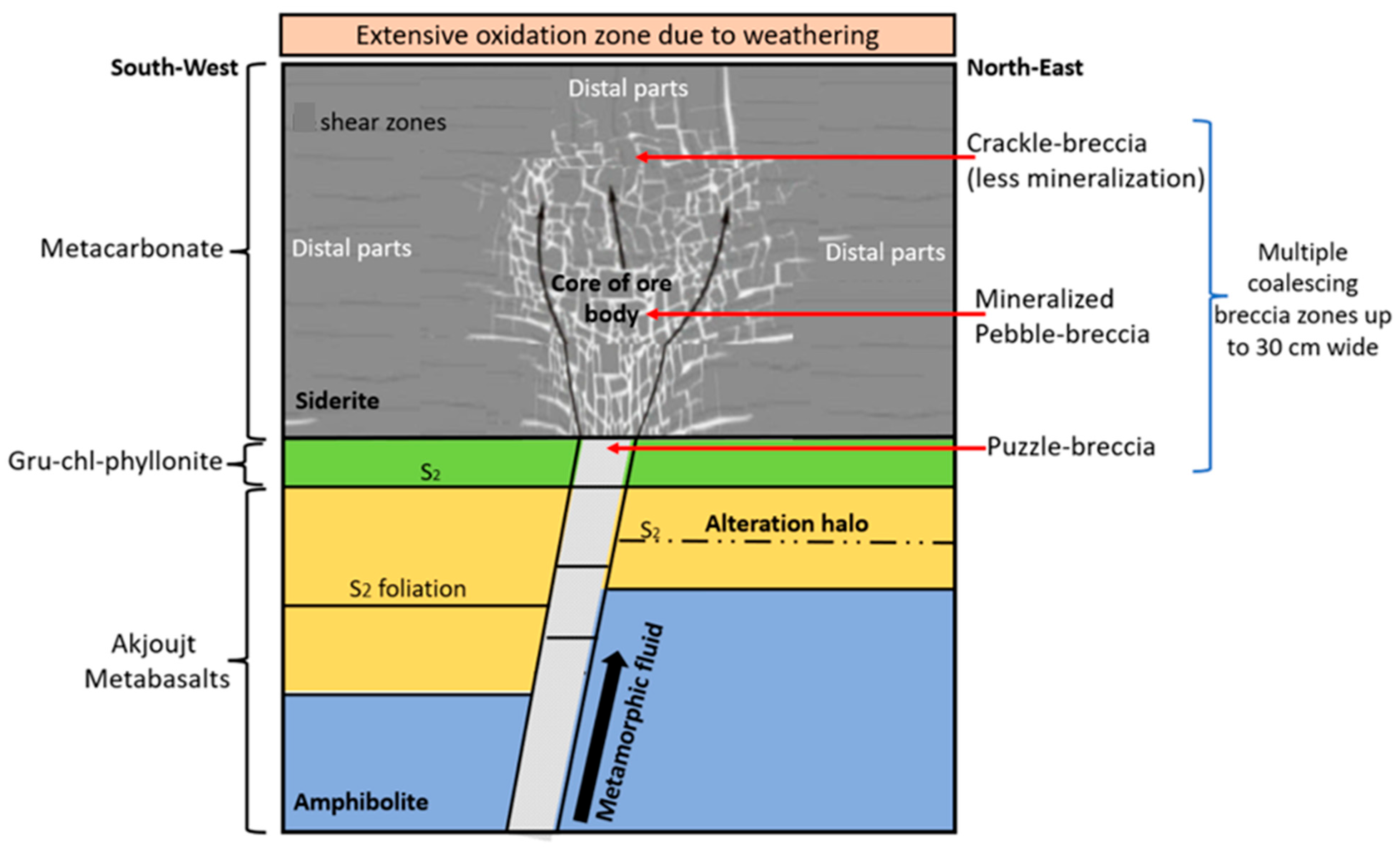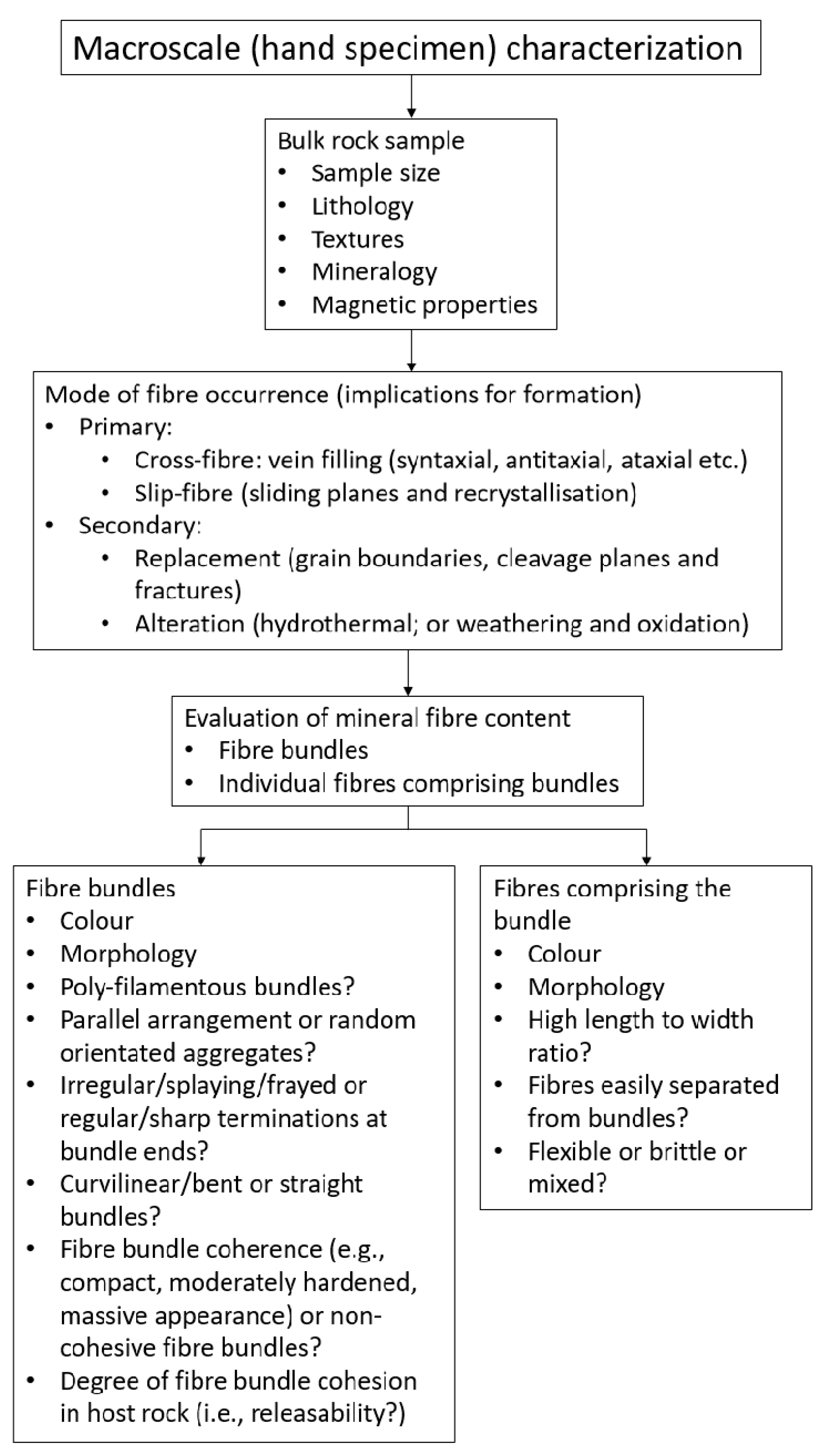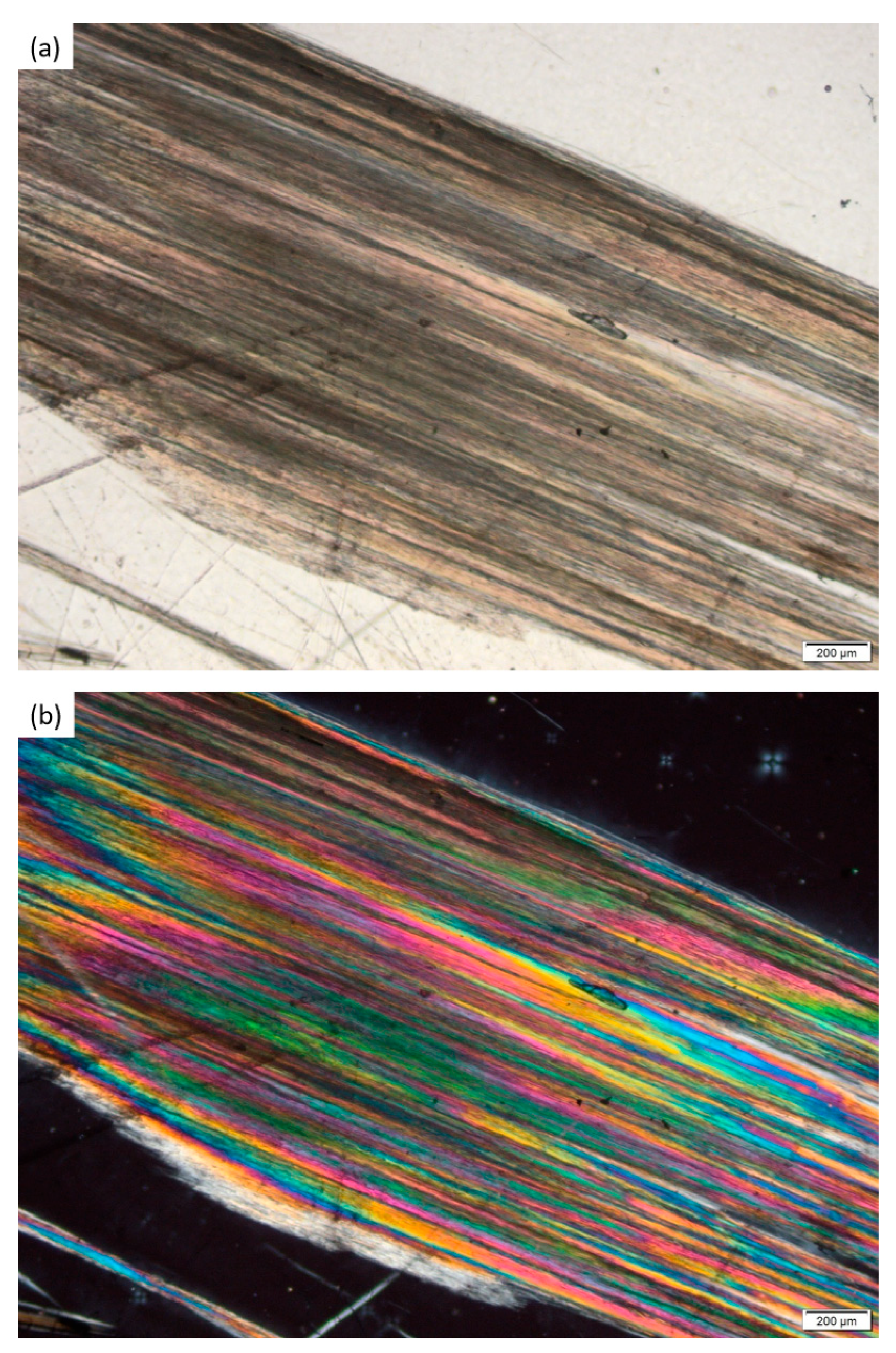Fibrous Minerals and Naturally Occurring Asbestos (NOA) in the Metacarbonate Hosted Fe Oxide-Cu-Au-Co Mineralized Rocks from the Guelb Moghrein Mine, Akjoujt, Mauritania: Implications for In Situ Hazard Assessment and Mitigation Protocols
Abstract
1. Introduction
2. Geological Background and Mineralisation
3. Materials and Methods
3.1. Sample Location and Collection
3.2. Sample Characterisation
3.3. Fibre Subsample Extraction; Distinguishing Fibrous and Pseudo-Fibrous Minerals; and Acid Test on Fibres (Determination of Carbonate Presence)
3.4. Mineralogical and Geochemical Investigation
3.4.1. Polarised Light Microscopy (PLM)
3.4.2. X-Ray Diffraction (XRD)
3.4.3. X-Ray Fluorescence (XRF)
3.4.4. BET-N2 Specific Surface Area
4. Results
4.1. Sample Characterisation
4.2. Polarised Light Microscopy (PLM)
4.3. X-Ray Diffraction (XRD), X-Ray Fluorescence (XRF) and BET-N2-Pecific Surface Area
5. Discussion
6. Implications for In Situ Identification and Health Risk Assessment
7. Conclusions
Supplementary Materials
Author Contributions
Funding
Data Availability Statement
Conflicts of Interest
References
- Lahondère, D.; Cagnard, F.; Wille, G.; Duron, J. Naturally occurring asbestos in an alpine ophiolitic complex (northern Corsica, France). Environ. Earth Sci. 2019, 78, 540. [Google Scholar] [CrossRef]
- Wagner, J. Analysis of serpentine polymorphs in investigations of natural occurrences of asbestos. Environ. Sci. Process. Impacts 2015, 17, 985–996. [Google Scholar] [CrossRef]
- Meeker, G.; Bern, A.; Brownfield, I.; Lower, H.; Sutley, S.; Hoefen, T.; Vance, J. The Composition and Morphology of Amphiboles from the Rainy Creek Complex, Near Libby, Montana. Am. Mineral. 2003, 88, 1955–1969. [Google Scholar] [CrossRef]
- Punturo, R.; Ricchiuti, C.; Bloise, A. Assessment of Serpentine Group Minerals in Soils: A Case Study from the Village of San Severino Lucano (Basilicata, Southern Italy). Fibers 2019, 7, 18. [Google Scholar] [CrossRef]
- National Institute for Occupational Safety and Health (NIOSH). Asbestos Fibers and Other Elongate Mineral Particles: State of the Science and Roadmap for Research. In Current Intelligence Bulletin; NIOSH: Cincinnati, OH, USA, 2011; Volume 62. [Google Scholar]
- Lucci, F.; Della Ventura, G.; Conte, A.; Nazzari, M.; Scarlato, P. Naturally Occurring Asbestos (NOA) in Granitoid Rocks, A Case Study from Sardinia (Italy). Minerals 2018, 8, 442. [Google Scholar] [CrossRef]
- Harper, M. 10th Anniversary critical review: Naturally occurring asbestos. J. Environ. Monit. 2008, 10, 1394–1408. [Google Scholar] [CrossRef]
- Metcalf, R.V.; Buck, B.J. Genesis and health risk implication of an unusual occurrence of NaFe3+ amphibole. Geology 2015, 43, 63–66. [Google Scholar] [CrossRef]
- Vignaroli, G.; Ballirano, P.; Belardi, G.; Rossetti, F. Asbestos fibre identification vs. evaluation of asbestos hazard in ophiolitic rock mélanges, a case study from the Ligurian Alps (Italy). Environ. Earth Sci. 2014, 72, 3679–3698. [Google Scholar] [CrossRef]
- Lockey, J.E.; Parry, W.T. Health implications of naturally occurring mineral fibers. Fam. Community Health 1984, 7, 1–7. [Google Scholar] [CrossRef]
- Vignaroli, G.; Rossetti, F.; Belardi, G.; Billi, A. Linking rock fabric to fibrous mineralisation: A basic tool for the asbestos hazard. Nat. Hazards Earth Syst. Sci. 2011, 11, 1267–1280. [Google Scholar] [CrossRef]
- Schapira, J.S.; Bolhar, R.; Master, S.; Wilson, A.H. Mineralogical, Petrological and Geochemical Characterisation of Chrysotile, Amosite and Crocidolite Asbestos Mine Waste from Southern Africa in Context of Risk Assessment and Rehabilitation. Minerals 2023, 13, 1352. [Google Scholar] [CrossRef]
- Giacomini, F.; Boerio, V.; Polattini, S.; Tiepolo, M.; Tribuzio, R.; Zanetti, A. Evaluating asbestos fibre concentration in meta-ophiolites: A case study from the Voltri Massif and Sestri–Voltaggio Zone (Liguria; NW Italy). Environ. Earth Sci. 2010, 61, 1621–1639. [Google Scholar]
- Lescano, L.; Marfil, S.; Maiza, P.; Sfragulla, J.; Bonalumi, A. Amphibole in vermiculite mined in Argentina: Morphology; quantitative and chemical studies on the different phases of production and their environmental impact. Environ. Earth. Sci. 2013, 70, 1809–1821. [Google Scholar]
- Vignaroli, G.; Rossetti, F.; Billi, A.; Theye, T.; Belardi, G. Structurally controlled growth of fibrous amphibole in tectonised metagabbro: Constraints on asbestos concentration in non-serpentinised rocks. J. Geol. Soc. 2020, 177, 103–119. [Google Scholar] [CrossRef]
- Van Orden, D.; Allison, K.; Lee, R. Differentiating amphibole asbestos from non-asbestos in a complex mineral environment. Indoor Built Environ. 2008, 17, 58–68. [Google Scholar] [CrossRef]
- Gray, D.; Cameron, T.; Briggs, A. Guelb Moghrein Copper Gold Mine, Inchiri, Mauritania; Guelb Moghrein Copper Gold Mine Technical Report NI 43-101; 2016; p. 109. Available online: https://minedocs.com/12/GuelbMoghrein_Technical_032016.pdf (accessed on 25 August 2025).
- Martyn, J.E.; Strickland, C.D. Stratigraphy, structure, and mineralization of the Akjoujt area, Mauritania. J. Afr. Earth Sci. 2004, 38, 489–503. [Google Scholar]
- Kirschbaum, M.J.; Hitzman, M.W. Guelb Moghrein: An unusual carbonate-hosted iron oxide copper-gold deposit in Mauritania, Northwest Africa. Econ. Geol. 2016, 111, 763–770. [Google Scholar] [CrossRef]
- Strickland, C.D.; Martyn, J.E. The Guelb Moghrein Fe-oxide copper–gold–cobalt deposit and associated mineral occurrences, Mauritania: A geological introduction. In Hydrothermal Iron Oxide Copper–Gold & Related Deposits: A Global Perspective; Porter, T.M., Ed.; PGC Publishing: Adelaide, Australia, 2002; pp. 275–291. [Google Scholar]
- Sakellaris, G.A. Petrology, Geochemistry, Stable and Radiogenic Isotopy of the Guelb Moghrein Iron oxide-Copper-Gold-Cobalt Deposit, Mauritania. Ph.D. Thesis, RWTH Aachen University, Aachen, Germany, 2007; 444p. [Google Scholar]
- Kolb, J.; Sakellaris, G.A.; Meyer, F.M. Controls on hydrothermal Fe oxide–Cu–Au–Co mineralization at the Guelb Moghrein deposit, Akjoujt area, Mauritania. Mineral. Depos. 2006, 41, 68–81. [Google Scholar]
- Bargmann, C.J.; Dominy, S.C. Technical Report on the Mauritania Copper Mines: Guelb Moghrein Resource Estimation Project No. L00131; NI 43-101 Technical Report for Mauritania Copper Mines; Snowden Mining Industry Consultants Limited: Perth, Australia, 2008. [Google Scholar]
- Abbot, P. A Review of Asbestos Resources. Master’s Thesis, Rhodes University, Grahams-Town, South Africa, 1983. Available online: https://core.ac.uk/download/pdf/145045443.pdf (accessed on 25 August 2025).
- Karunaratne, P.C.T.; Fernando, G.W.A.R. Characterisation and radiation impact of corrugated asbestos roofing sheets in Sri Lanka. J. Geol. Soc. Sri Lanka 2015, 17, 31–40. [Google Scholar]
- Vanoeteren, C.; Cornelis, R.; Verbeeck, P. Evaluation of trace elements in human lung tissue III. Correspondence analysis. Sci. Total Environ. 1986, 54, 237–245. [Google Scholar]
- Toth, G.; Hermann, T.; Da Silva, M.R.; Montanarella, L. Heavy metals in agricultural soils of the European Union with implications for food safety. Environ. Int. 2016, 88, 299–309. [Google Scholar] [CrossRef]
- Buck, B.J.; Goossens, D.; Metcalf, R.V.; McLaurin, B.; Ren, M.; Freudenberger, F. Naturally occurring asbestos: Potential for human exposure, Southern Nevada, USA. Soil Sci. Soc. Am. J. 2013, 77, 2192–2204. [Google Scholar] [CrossRef]
- Punturo, R.; Bloise, A.; Critelli, T.; Catalano, M.; Fazio, E.; Apollaro, C. Environmental implications related to natural asbestos occurrences in the ophiolites of the Gimigliano-Mount Reventino Unit (Calabria, southern Italy). Int. J. Environ. Res. 2015, 9, 405–418. [Google Scholar]
- Bloise, A.; Belluso, E.; Critelli, T.; Catalano, M.; Apollaro, C.; Miriello, D.; Barrese, E. Amphibole asbestos and other fibrous minerals in the meta-basalt of the Gimigliano-Mount Reventino Unit (Calabria, south-Italy). Rend. Online Soc. Geol. Ital. 2012, 21, 847–848. [Google Scholar]
- Bloise, A.; Barca, D.; Gualtieri, A.F.; Pollastri, S.; Belluso, E. Trace elements in hazardous mineral fibres. Environ. Pollut. 2016, 216, 314–323. [Google Scholar] [CrossRef]
- Bloise, A.; Catalano, M.; Barrese, E.; Gualtieri, A.F.; Gandolfi, N.B.; Capella, S.; Belluso, E. TG/DSC study of the thermal behaviour of hazardous mineral fibres. J. Therm. Anal. Calorim. 2016, 123, 2225–2239. [Google Scholar] [CrossRef]
- Bloise, A.; Punturo, R.; Catalano, M.; Miriello, D.; Cirrincione, R. Naturally occurring asbestos (NOA) in rock and soil and relation with human activities: The monitoring example of selected sites in Calabria (southern Italy). Ital. J. Geosci. 2016, 135, 268–279. [Google Scholar] [CrossRef]
- Bloise, A.; Catalano, M.; Critelli, T.; Apollaro, C.; Miriello, D. Naturally occurring asbestos: Potential for human exposure, San Severino Lucano (Basilicata, southern Italy). Environ. Earth Sci. 2017, 76, 648. [Google Scholar] [CrossRef]
- Bloise, A.; Ricchiuti, C.; Giorno, E.; Fuoco, I.; Zumpano, P.; Miriello, D.; Apollaro, C.; Crispini, A.; De Rosa, R.; Punturo, R. Assessment of naturally occurring asbestos in the area of Episcopia (Lucania, Southern Italy). Fibers 2019, 7, 45. [Google Scholar] [CrossRef]
- Petriglieri, J.R.; Laporte-Magoni, C.; Gunkel-Grillon, P.; Tribaudino, M.; Bersani, D.; Sala, O.; Salvioli-Mariani, E. Mineral fibres and environmental monitoring: A comparison of different analytical strategies in New Caledonia. Geosci. Front. 2020, 11, 189–202. [Google Scholar] [CrossRef]
- Dichicco, M.C.; Paternoster, M.; Rizzo, G.; Sinisi, R. Mineralogical asbestos assessment in the Southern Apennines (Italy): A Review. Fibers 2019, 7, 24. [Google Scholar] [CrossRef]
- Case, B.W.; Marinaccio, A. Epidemiological approaches to health effects of mineral fibres: Development of knowledge and current practice. In Mineral Fibers: Crystal Chemistry, Chemical-Physical Properties, Biological Interaction and Toxicity; Gualtier, A.F., Ed.; European Mineralogical Union: London, UK, 2017; Volume 18, pp. 376–406. [Google Scholar]
- Punturo, R.; Cirrincione, R.; Pappalardo, G.; Mineo, S.; Fazio, E.; Bloise, A. Preliminary laboratory characterization of serpentinite rocks from Calabria (southern Italy) employed as stone material. J. Mediterr. Earth Sci. 2018, 10, 79–87. [Google Scholar]
- Militello, G.M.; Bloise, A.; Gaggero, L.; Lanzafame, G.; Punturo, R. Multi-Analytical Approach for Asbestos Minerals and Their Non-Asbestiform Analogues: Inferences from Host Rock Textural Constraints. Fibers 2019, 7, 42. [Google Scholar] [CrossRef]
- Ellis, D.J.; Hiroi, Y. Secondary siderite–oxide–sulphide and carbonate–andalusite assemblages in cordierite granulites from Sri Lanka: Post-granulite facies fluid evolution during uplift. Contrib. Mineral. Petrol. 1997, 127, 315–335. [Google Scholar] [CrossRef]
- Dutrow, B.L.; Henry, D.J. Fibrous tourmaline: A sensitive probe of fluid compositions and petrologic environments. Can. Mineral. 2016, 54, 311–335. [Google Scholar] [CrossRef]
- Dutrow, B.L.; Henry, D.J. Complexly zoned fibrous tourmaline, Cruzeiro mine, Minas Gerais, Brazil: A record of evolving magmatic and hydrothermal fluids. Can. Mineral. 2000, 38, 131–143. [Google Scholar] [CrossRef]
- Oberdörster, G. Toxicokinetics and effects of fibrous and nonfibrous particles. Inhal. Toxicol. 2002, 14, 29–56. [Google Scholar] [CrossRef]
- Vigliaturo, R.; Ventura, G.D.; Choi, J.K.; Marengo, A.; Lucci, F.; O’Shea, M.J.; Pérez-Rodríguez, I.; Gieré, R. Mineralogical Characterization and Dissolution Experiments in Gamble’s Solution of Tremolitic Amphibole from Passo di Caldenno (Sondrio, Italy). Minerals 2018, 8, 557. [Google Scholar] [CrossRef] [PubMed]
- Bloise, A.; Ricchiuti, C.; Punturo, R.; Pereira, D. Potentially toxic elements (PTEs) associated with asbestos chrysotile, tremolite and actinolite in the Calabria region (Italy). Chem. Geol. 2020, 558, 119896. [Google Scholar] [CrossRef]
- Gualtieri, A.F.; Pollastri, S.; Gandolfi, N.B.; Gualtier, M.L. In vitro acellular dissolution of mineral fibres: A comparative study. Sci. Rep. 2018, 8, 7071. [Google Scholar] [CrossRef]
- Lee, Y.J.; Lim, S.S.; Baek, B.J.; An, J.M.; Nam, H.S.; Woo, K.M.; Cho, M.K.; Kim, S.H.; Lee, S.H. Nickel (II)-induced nasal epithelial toxicity and oxidative mitochondrial damage. Environ. Toxicol. Pharmacol. 2016, 42, 76–84. [Google Scholar] [CrossRef] [PubMed]
- Jaishankar, M.; Tseten, T.; Anbalagan, N.; Mathew, B.B.; Beeregowda, K.N. Toxicity, mechanism, and health effects of some heavy metals. Interdiscip. Toxicol. 2014, 7, 60–72. [Google Scholar] [CrossRef] [PubMed]
- Martin, S.; Griswold, W. Human health effects of heavy metals. Environ. Ment. Sci. Technol. Briefs Citiz. 2009, 15, 1–6. [Google Scholar]






| Oxides (wt%) | Trace Elements (ppm) | Elements in Human Lungs (ppm) (Vanoeteren et al., 1986) [26] | Threshold Values (ppm) (Toth et al., 2016) [27] | ||
|---|---|---|---|---|---|
| SiO2 | 19.73 | Sc | 100 | ND | NA |
| Al2O3 | 0.08 | V | DL | 0.50 | 100 |
| Fe2O3 | 34.13 | Cr | DL | 0.50 | 100 |
| MnO | 1.43 | Co | DL | 0.10 | 20 |
| MgO | 17.70 | Ni | 43.9 | 1.00 | 50 |
| CaO | 0.88 | Cu | 7419 | 5.00 | NA |
| Na2O | 0.00 | Zn | 1.3 | 30 | 200 |
| K2O | 0.02 | Ga | DL | NA | NA |
| TiO2 | 0.01 | Rb | 0.65 | 10 | NA |
| P2O5 | 0.12 | Sr | 1.5 | 1 | NA |
| Cr2O3 | 0.00 | Y | 7.01 | ND | NA |
| NiO | 0.01 | Zr | 0.06 | NA | NA |
| LOI | 22.02 | Nb | 0.72 | NA | NA |
| Mo | 1.53 | NA | NA | ||
| Ba | DL | >1.10 | NA | ||
| Pb | 8.42 | 0.50 | 60 | ||
| Th | DL | ND | NA | ||
| U | DL | 0.005 | NA | ||
| Total | 96.09 | 7585 | |||
Disclaimer/Publisher’s Note: The statements, opinions and data contained in all publications are solely those of the individual author(s) and contributor(s) and not of MDPI and/or the editor(s). MDPI and/or the editor(s) disclaim responsibility for any injury to people or property resulting from any ideas, methods, instructions or products referred to in the content. |
© 2025 by the authors. Licensee MDPI, Basel, Switzerland. This article is an open access article distributed under the terms and conditions of the Creative Commons Attribution (CC BY) license (https://creativecommons.org/licenses/by/4.0/).
Share and Cite
Schapira, J.S.; Bolhar, R. Fibrous Minerals and Naturally Occurring Asbestos (NOA) in the Metacarbonate Hosted Fe Oxide-Cu-Au-Co Mineralized Rocks from the Guelb Moghrein Mine, Akjoujt, Mauritania: Implications for In Situ Hazard Assessment and Mitigation Protocols. Minerals 2025, 15, 991. https://doi.org/10.3390/min15090991
Schapira JS, Bolhar R. Fibrous Minerals and Naturally Occurring Asbestos (NOA) in the Metacarbonate Hosted Fe Oxide-Cu-Au-Co Mineralized Rocks from the Guelb Moghrein Mine, Akjoujt, Mauritania: Implications for In Situ Hazard Assessment and Mitigation Protocols. Minerals. 2025; 15(9):991. https://doi.org/10.3390/min15090991
Chicago/Turabian StyleSchapira, Jessica Shaye, and Robert Bolhar. 2025. "Fibrous Minerals and Naturally Occurring Asbestos (NOA) in the Metacarbonate Hosted Fe Oxide-Cu-Au-Co Mineralized Rocks from the Guelb Moghrein Mine, Akjoujt, Mauritania: Implications for In Situ Hazard Assessment and Mitigation Protocols" Minerals 15, no. 9: 991. https://doi.org/10.3390/min15090991
APA StyleSchapira, J. S., & Bolhar, R. (2025). Fibrous Minerals and Naturally Occurring Asbestos (NOA) in the Metacarbonate Hosted Fe Oxide-Cu-Au-Co Mineralized Rocks from the Guelb Moghrein Mine, Akjoujt, Mauritania: Implications for In Situ Hazard Assessment and Mitigation Protocols. Minerals, 15(9), 991. https://doi.org/10.3390/min15090991






